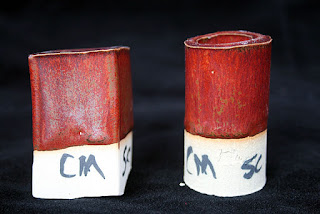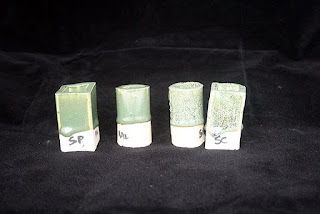The following are glaze test results recently fired. All of the tests were fired either at cone 6 and fast cooled or at cone 6 and slow cooled. Two different clays were used for each glaze. The round pieces are Standard 153 and the square tests are Standard 182. The tests will be repeated with Standard 112 in the near future. Some of the glazes came from our regular studio glaze set and some from other sources. Each piece was dipped once, then dipped again at the top to see thickness effects. The results are interesting in several ways. First, slow cooling does not produce good results in all glazes, although for some glazes it is necessary. Second, some of the glazes from MC6G (Mastering Cone 6 Glazes) which should need slow cooling, seem to be more attractive at straight cone 6 without slow cooling, which might make them candidates for inclusion in our studio glaze set. Third, the glaze application is important. Many of the glaze tests have too thick an application which may be affecting the better appearance of the glaze if thinly applied. Fourth, the type of clay has an effect in the appearance in some, but not all glazes.
Here are images of the results. In each, the fast cooled pieces are on the left, the slow cooled on the right. On some pieces you can see the additional effect of a brush of breaking glaze.
Click on each image to see larger version.
Randy's Red
The better appearance seems to be related to clay (153) rather than cooling program. Notice also that the heavier application at the top produced some variation.
Gloria's
Main effect is thickness. Too thick an application overcomes the "toast" look.
No effect from slow cooling.
MC6G Variegated Blue
Definite effect from slow cooling, however the cone 6 version is very attractive.
A close up of the two versions of Variegated Blue
VC 72 base with New Blue colorants.
Not much effect from slow cooling, but this glaze doesn't have the problems of the old New Blue (running, turning pea green at cone 6). It also shows another variation with thickness of application.
Test batch is available in the studio for your use.
MC6G Clear Powder Blue
Definite effect from slow cooling, but both versions are attractive.
Bill Van Gilder's Crocus Red
Previous firings of this glaze at cone 6 or less without slow cooling produced dark browns. This is one that really requires slow cooling to get the red appearance, but proves you can get red reds at cone 6.
Bailey Yellow
Fast cooled version looks better than slow cooled, but still not yellow enough for studio needs. Not a bad "sand" color though and very well behaved.
Test batch is in the studio for your use.
"Green Ice" - a version of MC6G Spearmint.
Definite effect from slow cooling which brings out the crystalline growth in the glaze. The fast cooled is not unattractive, but lacks depth. MC6G original Spearmint will be tested soon.
The following two use glazes not presently in the studio, but illustrate the possibilities in combining glazes to get new effects.
Kavanaugh Berry Rust over Cream Rust
MC6G Waterfall Brown over Field Mouse Brown











No comments:
Post a Comment